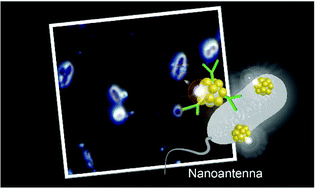Development of highly sensitive optical nanoantenna for bacterial detection†
Abstract
Gold nanoparticles (AuNPs) are chemically stable and serve as excellent labels because their characteristic red coloration based on the localized surface plasmon resonance (LSPR) does not fade. However, it is necessary to control the structure of AuNPs to use them as labels for various analyses, because their optical properties depend strongly on their size, shape, and state of aggregation. In this study, we developed gold nanostructures (AuNSs) by encapsulating many small AuNPs within a polymer for scattering light-based bacterial detection. The AuNSs consisting of many small nanoparticles provided stronger scattered light intensity than a single AuNP of the same particle size. We found that the aggregation of the AuNSs enhanced the scattering light intensity, depending strongly on their aggregation states, and did not affect the wavelength of the scattering light observed under a dark-field microscope. By specifically binding the antibody-introduced AuNSs to the antigen on the bacterial surface, it was possible to label the target bacteria and detect them based on their light scattering characteristics. In addition, to improve the accuracy of the selective identification of the cells of interest, labels based on scattered light should ideally have a fixed wavelength of scattered light with high intensity. From these perspectives, we developed a method of constructing an optical antenna on the surface of target bacterial cells using antibody-introduced NSs.



 Please wait while we load your content...
Please wait while we load your content...